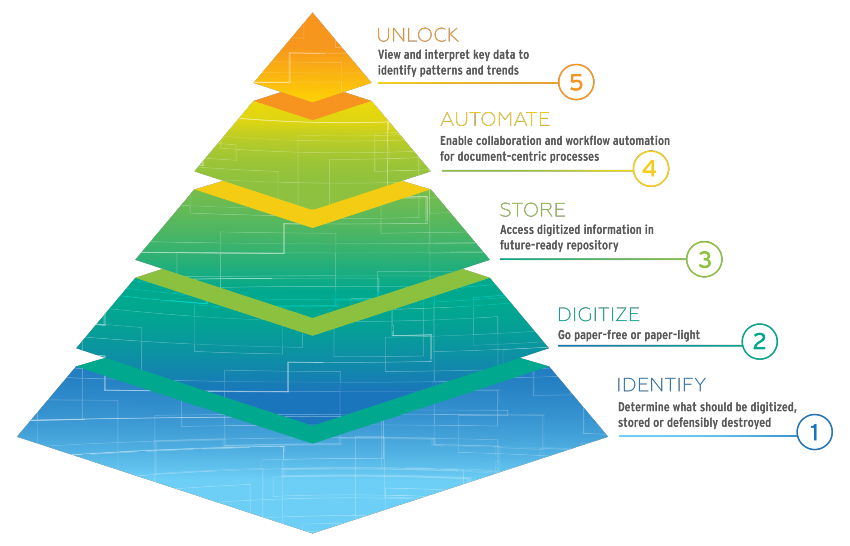Starting your digital transformation journey on the right step
Digital transformation is the adoption or integration of technology to improve business processes.

Believe it or not, heading straight for the scanner is not the first step to digital transformation. While 90.5% of organisations have implemented digitisation of physical records for ease of access or safe-keeping,* a truly successful and sustainable digital transformation requires a much more strategic approach.
Whether you’re just starting out or in the midst of going digital, it’s a good idea to take a step back and assess your implementation strategy to ensure you meet your business objectives along the way.
Embarking on your digital transformation journey
Through our decades of experience working with clients across industries, we’ve identified five key steps to a successful digital transformation strategy. While we see organisations try to skip ahead to automation, they often get stuck because they haven’t done the initial groundwork.
Before you embark on your digital transformation journey, it’s critical to start with the first two steps: identify what you have and digitise what you want to keep. A lot goes into these steps, so let’s dive in.
What to keep and what to toss—identify your records
Many organisations default to a “keep everything” culture—retaining files in perpetuity. But this isn’t cost-effective, compliant, or practical. Before going digital, it’s imperative to have a clear understanding of your records inventory.
Here are some key questions to consider as you determine the value of your records prior to digitisation:
- What is the content format? Unique content types like paper, tape, microfiche, or electronic files have different uses. If these aren’t integrated in a unified information management platform, there isn’t an effective way to derive useful insights.
- How do you classify your content? Whether it’s personally identifiable information (PII) or sensitive business data, classifying your content in a way that makes sense for your industry’s standards and policies will help ensure it’s accessible by the organisation.
- What do you do with your content? Define how your organisation uses its records, whether it’s for day-to-day work or to achieve long-term business objectives. To counteract operational inefficiencies, look for work processes that can be made easier or more efficient by converting paper to digital records.
- How do you prioritise your content? If you can’t get specific information when you need it, that’s an additional cost to your business. This impacts SLAs, people, process, customers, brand, and ultimately your organisation’s reputation.
- Where is the content? Records are typically spread across systems, applications, format types, departments, and locations, which can make them challenging and costly to manage.
By taking stock of what you have, you can avoid common pitfalls like:
-
Poor visibility and access to files
-
Commingled destruction dates
-
Mixed record types
-
Multiple content repositories
-
Duplicates and unapproved versions
This also prevents over-retention of your records, avoiding risk due to keeping data longer than you should and spending more on storage costs.
Setting a records retention schedule
An important but often overlooked part of the digital transformation journey includes developing your organisation’s retention schedule based on your industry’s standards and policies. Preserving information and systematically destroying records are two sides of the same coin. Thoughtful retention informs the way your company manages intellectual property and supports business processes.
We’ve found that tracking event dates can be the biggest challenge when moving physical records to a digital environment. When you have tens of thousands of boxes, keeping records based on event dates can be difficult to forecast, challenging to keep up-to-date when stored offsite, and costly to index.
With a solid records retention schedule, you’ll:
-
Have a unified view of your personal data and related obligations
-
Adhere to regulatory and compliance requirements
-
Reduce unnecessary exposure to data breaches
If this seems overwhelming, don’t worry. We’ve got you covered.
Moving forward with digitisation
Great news! After you’ve identified the contents of your records inventory and set your retention schedule, it’s now time to scan the files you decided to keep. Once you know what you’re keeping and where it’s kept, you’ll be in a better position to make a scanning project effective and efficient.
Records management processes and procedures can be hard to keep under control, especially when not in a digital format. Document sharing and collaboration are essential for the success of your business, and digitising your records makes it all possible.
A foundation for success
Now that you’ve laid a solid foundation for a successful digital transformation (steps 1 and 2), you’re ready to build a future-ready central repository where your team can access and collaborate on digital information (step 3). You’re also closer to the next steps of workflow automation and unlocking your information, so your team will be able to streamline business processes and glean valuable insights from your data.
Jumpstart your digital transformation here.
If you weren’t able to attend our two-part AIIM webinar series, From Paper to Digital: The Digital Transformation Journey, you can watch Part 1 on-demand and Part 2 on-demand now.
*Research by Economist Impact, supported by Iron Mountain
Featured services & solutions
Related resources
View More Resources Premium
Premium

